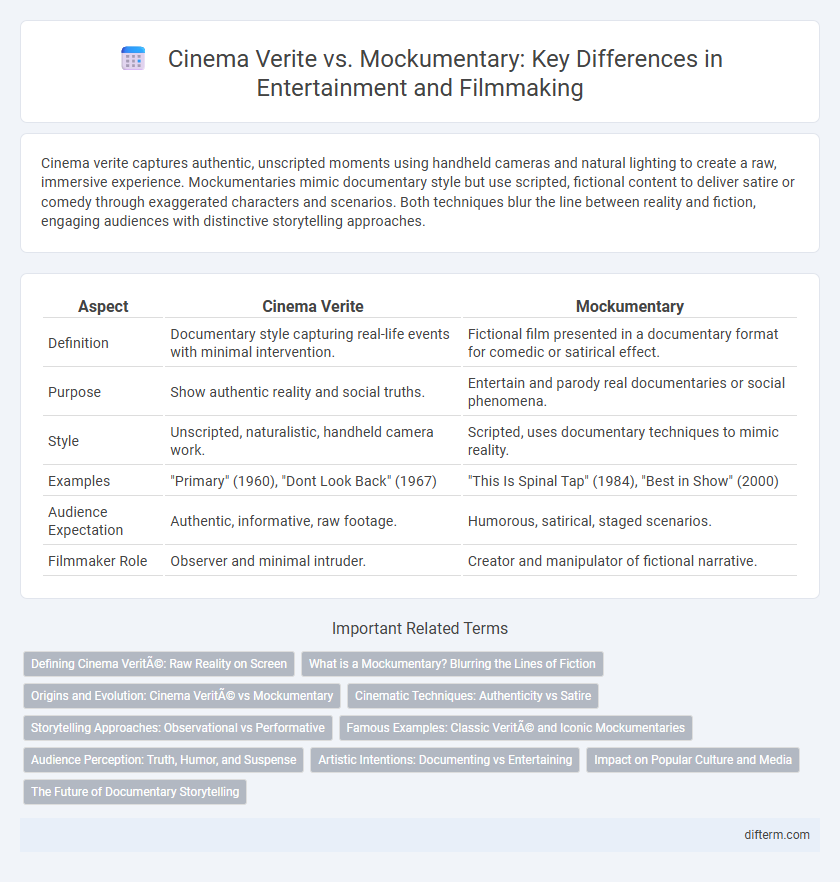Cinema verite captures authentic, unscripted moments using handheld cameras and natural lighting to create a raw, immersive experience. Mockumentaries mimic documentary style but use scripted, fictional content to deliver satire or comedy through exaggerated characters and scenarios. Both techniques blur the line between reality and fiction, engaging audiences with distinctive storytelling approaches.
Table of Comparison
| Aspect | Cinema Verite | Mockumentary |
|---|---|---|
| Definition | Documentary style capturing real-life events with minimal intervention. | Fictional film presented in a documentary format for comedic or satirical effect. |
| Purpose | Show authentic reality and social truths. | Entertain and parody real documentaries or social phenomena. |
| Style | Unscripted, naturalistic, handheld camera work. | Scripted, uses documentary techniques to mimic reality. |
| Examples | "Primary" (1960), "Dont Look Back" (1967) | "This Is Spinal Tap" (1984), "Best in Show" (2000) |
| Audience Expectation | Authentic, informative, raw footage. | Humorous, satirical, staged scenarios. |
| Filmmaker Role | Observer and minimal intruder. | Creator and manipulator of fictional narrative. |
Defining Cinema Verité: Raw Reality on Screen
Cinema verite captures raw reality on screen through unobtrusive filming that emphasizes natural lighting, authentic dialogue, and spontaneous interactions. This documentary style avoids scripted narration, aiming to present life as it unfolds, offering viewers an unfiltered glimpse into genuine human experiences. Unlike mockumentaries, which parody real-life events with fictionalized humor, cinema verite maintains a commitment to truthful social observation.
What is a Mockumentary? Blurring the Lines of Fiction
A mockumentary is a style of film or television that mimics the documentary format while presenting fictional events with satirical or comedic undertones. It blurs the lines of fiction by using realistic filming techniques, interviews, and handheld camera work, creating an illusion of authenticity that challenges viewers' perceptions of truth. Popular examples such as "This Is Spinal Tap" and "The Office" showcase how mockumentaries blend narrative storytelling with documentary aesthetics to deliver social commentary or humor.
Origins and Evolution: Cinema Verité vs Mockumentary
Cinema verite originated in the 1960s as a French documentary style emphasizing naturalistic, unobtrusive filming to capture authentic moments, reflecting sociopolitical realities. Mockumentaries emerged later, notably popularized in the 1980s and 1990s, blending fictional storytelling with documentary techniques to create satirical or comedic narratives. Both forms evolved by challenging traditional boundaries between reality and fiction, influencing contemporary cinematic approaches to truth and representation.
Cinematic Techniques: Authenticity vs Satire
Cinema verite employs handheld cameras, natural lighting, and real locations to capture raw, unfiltered moments that emphasize authenticity and spontaneous interactions. Mockumentaries use scripted scenarios, exaggerated acting, and fabricated settings to parody documentary style, blending satire with cinematic techniques that mimic realism. Both genres manipulate cinematic tools to evoke distinct audience responses, one fostering genuine immersion and the other, critical humor.
Storytelling Approaches: Observational vs Performative
Cinema verite emphasizes a raw, observational storytelling approach that captures real-life events with minimal interference, creating an authentic viewer experience. Mockumentaries utilize a performative style, blending scripted scenarios with documentary techniques to parody or satirize reality. These contrasting methods highlight cinema verite's commitment to genuine portrayal, while mockumentaries prioritize creative expression and humor through intentional dramatization.
Famous Examples: Classic Verité and Iconic Mockumentaries
Cinema verite classics include Jean Rouch's "Chronicle of a Summer" and D.A. Pennebaker's "Don't Look Back," known for their raw, observational style capturing real-life events with minimal interference. Iconic mockumentaries like Rob Reiner's "This Is Spinal Tap" and Christopher Guest's "Best in Show" use scripted humor and fictional scenarios to mimic documentary conventions, creating satirical and entertaining narratives. Both styles have significantly influenced documentary filmmaking by blurring lines between reality and fiction for dramatic or comedic effect.
Audience Perception: Truth, Humor, and Suspense
Cinema verite emphasizes authentic, unfiltered reality, engaging audiences through raw, unscripted moments that create a sense of truth and immediacy. Mockumentaries blend fictional storytelling with documentary style, eliciting humor while simultaneously playing with audience expectations about truth and fiction. The contrast in audience perception lies in cinema verite's pursuit of genuine experience versus mockumentary's crafted suspense and comedic irony.
Artistic Intentions: Documenting vs Entertaining
Cinema verite aims to capture reality with minimal interference, emphasizing authentic, unfiltered experiences to document truthful social or personal narratives. In contrast, mockumentaries blend fictional storytelling with documentary style, prioritizing entertainment through satire, humor, and constructed scenarios. The artistic intention behind cinema verite centers on genuine observation, while mockumentaries focus on creative engagement and audience amusement.
Impact on Popular Culture and Media
Cinema verite revolutionized popular culture by introducing raw, unfiltered realism that influenced documentary filmmaking and news media authenticity. Mockumentaries satirize societal norms and entertainment tropes, reshaping comedic storytelling and audience engagement through parody and irony. Both genres significantly impacted media by blurring the line between fiction and reality, fostering critical media literacy and diversified narrative frameworks.
The Future of Documentary Storytelling
Cinema verite emphasizes authentic, unscripted footage capturing reality with minimal interference, fostering raw and immersive storytelling. Mockumentaries blend fictional narratives with documentary style, allowing for satirical or comedic critiques while engaging viewers through familiar documentary conventions. The future of documentary storytelling will likely integrate these approaches, utilizing advanced technology and narrative innovation to blur lines between truth and fiction, enhancing audience engagement and expanding creative possibilities.
cinema verité vs mockumentary Infographic

 difterm.com
difterm.com